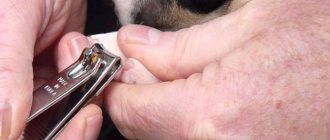The question of how to untie a male dog often arises both among novice dog breeders who decide to start breeding puppies, and among those who simply believe that their pet needs it. On the one hand, the concern of owners about their dog’s first mating looks somewhat strange. The animal intuitively knows what and how it should do, because in nature animals reproduce without human control. On the other hand, unsuccessful untying is quite capable of becoming the reason that the male will not be able to participate in breeding in the future. Therefore, it is extremely important for owners of highly purebred animals that their pet’s “first time” is successful.
What is knitting? Concept
Before untying a dog for the first time, especially a purebred dog that has value for breeding, you need to find out what exactly dog mating is and how it happens.
The definition of this process sounds simple enough. Mating, or mating, mating is a set of actions planned by a person, leading to the fertilization of the eggs of bitches with the seminal fluid of males under the control of the owners.
This is the difference between mating and the natural mating of animals, to which humans have nothing to do. Also, the mating of purebred dogs is legally accompanied, in fact being a business transaction. Animal owners enter into agreements that stipulate the obligations and rights of the parties, the material and financial aspects of the upcoming event.
Physiological features of puberty
The genital organs of male dogs are a complex system consisting of testes with appendages, vas deferens, accessory gonads and penis. During intrauterine development and in the first few weeks (sometimes days) of a puppy’s life, the testes are located in the abdominal cavity. With the correct formation of the body, by 2–5 months they descend into the scrotum. As a result of certain factors, such as stress, cold or fear, the testes may rise into the pelvic area. This is a normal reaction of the body of a young animal, which should not cause concern to its owner. The male penis has a small bone inside, and along its entire length and closer to the base there are cavernous bodies that swell during arousal. Swelling of the bulbs and corpora cavernosa can be observed even in small puppies, and this is not a pathology.
What kind of mating can it be?
In the minds of most middle-aged people, those who had dogs in the pre-perestroika period, when in the country a purebred animal with a pedigree could be purchased only through membership in DOSAAF, matings can be unscheduled and official. In principle, a similar division applies to today.
From matings carried out outside the breeding plan of the canine society in which the dog is registered, puppies are born that do not have rights to pedigrees and other documents confirming their origin. Official or, as they more often say, planned matings are the mating of animals, after which puppies are born, registered by the club, receiving a pedigree and other documents.
Why might mating not happen?
Surprisingly, it sometimes happens that despite all the favorable conditions, dogs do not mate. There can be many reasons. For example, a male dog is very shy and refuses to mate in the presence of strangers. Dogs may simply not like each other. It happens that a bitch flatly refuses to mate with one male, snaps at him, bites him, but behaves perfectly with the other and the mating goes well. Do not forget that dogs are highly organized and social creatures with their own preferences and principles.
Don't forget the importance of courtship. Do not rush the dogs, give them the opportunity to flirt with each other, perform a series of ritual actions - licking ears, chasing, kissing, etc.
How is mating understood in breeding work?
What is selection in simple words? This is a determination, the choice of the most suitable partner for an animal, allowing to obtain offspring with specific characteristics. In how to untie a stud dog that is valuable in breeding, this point is extremely important.
In breeding work, two types of matings are distinguished:
- inbreeding;
- cross
The term “inbreeding” refers to the mating of closely related animals. These matings make it possible to obtain offspring with impeccable characteristics that best meet the requirements of the breed standards.
Cross mating involves the mating of animals that do not have common ancestors in their pedigrees.
Both types of selective selection of a partner for a dog have both advantages and disadvantages, which, of course, relate not to the mating process, but to the offspring. Often, owners of stud dogs do not consider it necessary to delve into the nuances of breeding work, simply trusting the zoologist from the kennel club. Particularly often they do not pay attention to the type of choice of a partner in cases when the question of how to untie a male dog is being decided.
On the one hand, this position is somewhat justified, because the sale of puppies will be the responsibility of the owners of the bitch. But on the other hand, the offspring of a male dog is his reputation, a kind of “calling card”. Few owners of bitches would want to breed their pet with an animal that produces sick or severely defective puppies, even if he has collected all the titles in the world. Therefore, you need to be very careful when choosing a partner, starting from the very first time.
This is already myth #2. Pyometra and breast tumors.
Statistics have long proven that the only way to minimize the risk of mammary gland diseases and tumors in an adult female dog is to spay her before her first heat! While her feminine essence is still sleeping in her puppy body.
From a psychological point of view, the absence of mating in the life of a dog, be it a female or a male, does not matter, does not in any way affect its emotional state. Remember, in the wild, not every female gives birth to puppies and not every male is a sire. Only the strongest and most viable individuals in the flock mate.
Are there any peculiarities in the first mating?
Of course, the first time is special, for both people and dogs. However, these features are radically different. Animals do not need to create a romantic atmosphere, but the presence of an instructor will not hurt. Its functions can also be performed by the owner, but only if the person has practical experience in mating animals. In the case where there is no such experience, it makes sense to insist that the instructor not only carry out the mating, but train the owner. This will be useful in the future, because purebred dogs breed more than one or even a couple of females per year.
What is a person’s task during the first mating? It's about becoming part of the ritual. A dog should be calm about the fact that a person touches him, corrects him, helps him. As a rule, inexperienced dog breeders have a question about why this is needed. In how to untie a dog, human participation may not be required. But if the animal does not consider from the very first time that the person is part of the sexual contact, if any difficulties arise in the future, it simply will not allow its owners or instructors to approach it.
Of course, if we are talking about small dogs, then this is not a particularly important point. But if we are talking about mating representatives of large serious breeds, for example, mastiffs or shepherds, the habit of human participation is important.
For example, a bitch’s muscles will cramp while standing “in the castle.” Help will be needed to free the dog in the truest sense of the word. If a dog weighs over a hundred kilograms and has a fairly stern disposition, it will simply be impossible to approach it without shooting a dart with a sleeping pill. But if the dog immediately learns that the person is guiding him, is in contact - stroking him, pulling his ears, then the situation will be resolved differently and will not become stressful.
This means that in how to untie a male shepherd or other large breed, the participation of the owner and instructor is not only desirable, but also mandatory.
To untie or not
Before making such an important decision, it is important to know what you are faced with:
- The regularity of the bribe. Can you provide regular mating? If yes, then you can untie it. Otherwise, there will be consequences - the dog will start rushing to every bitch, it will be extremely difficult to train her, and in general, once he has tried a girl, he will no longer be able to forget about it. The main thing for the male dog is to create a situation again in order to achieve sexual intercourse. For the owner, this is fraught with diseases in the dog, which are not always easy to cure.
- Diseases. You cannot breed a dog with a medical condition. If you are ready to go to the veterinarian to conduct a full range of studies, including tests, you can do this.
- Permanent partner. A male dog must have a permanent female to mate with. If you have an option in mind, why not take it? Just keep in mind that not only your dog needs to undergo examinations, but also the bitch, otherwise in case of illnesses she will infect the dog.
- Conditions of detention. In order for the puppies born with your male to be healthy, you need to provide the best living conditions for the dog. If you are able to do this, you can untie it.
What exactly should the owner do at the first mating?
The answer to this question seems simple - to participate. But how exactly to do this? Often, animal owners who have no experience in breeding animals are as nervous before the upcoming event as if it were their own wedding. And this is precisely what cannot be done. The human's excitement is transmitted to the animal. And the dog’s psyche is structured in such a way that when it senses the owner’s nervous tension, the dog tunes in to protect him. Accordingly, he will be wary and aggressive towards the bitch, her owners and instructor.
The very actions that a person should carry out are extremely simple. When a male jumps onto a bitch, that is, makes a mount, you need to put your hand on his croup. There is no need to guide the animal unless there is a need for it. The point of the action is for the dog to get used to it and, if difficulties arise, not to be afraid or defend itself. Repeating this movement is required every time the male begins to mount. When dogs freeze in the castle, you need to pet the animal, pull behind the ears, but, of course, without effort. If other actions are required, the instructor leading the pairing will inform you about this.
What is a lock and what is it for?
After a short courtship, dogs engage in sexual intercourse. Ejaculation in a male dog occurs quite quickly, literally after several frictions. However, the bitch does not let him go so quickly: the muscles of her vagina contract and a “lock” occurs. Your help is very important here, because... the dogs in the “castle” tend to run away, the bitch tries to sit down, all this can injure both, especially the male. Carefully turn the dogs with their tails facing each other and hold them in a standing position until the bitch releases the male.
The “lock” in nature is designed not only to hold sperm inside the bitch’s genitals, but also to prolong her pleasure.
Typically the “lock” lasts from 5 to 40 minutes. However, if the “lock” does not occur, fertilization can occur without it.
Is it necessary to do this?
Despite the great similarity between the organisms of dogs and people, four-legged pets still differ from their owners. Nature intended that dogs, like many other animals, have sex very differently from humans. They do this solely for the sake of procreation, the appearance of offspring. Therefore, the “he wants it” arguments are wrong. A male dog will want it after he learns what a bitch in heat is and how to deal with her.
This means that after the first mating, others will be needed. When considering whether to untie a male dog, this is the first thing to think about. You should not rely on chance, that is, assume that a male, unlike a female, can satisfy his needs with any dog. Physiologically this is certainly true, but this “any” also needs to be found. Accordingly, you first need to study the demand for matings in your region.
Male sex education
A male's readiness to mate is determined not only by his physiological state, but also by his psychological development. Dogs are characterized by complex social behavior based on a system of tactile, visual and olfactory communications. From birth, a puppy needs to master these skills, otherwise he will not acquire the ability to establish and maintain contacts with his relatives or have a full sex life.
The basic rule when raising a pet is to ensure close communication with other dogs. Sometimes owners believe that human society is enough for a male dog, and contacts with fellow dogs will only end in injury or infectious diseases. This is fundamentally wrong, because the animal is not insured against injuries, and vaccination is carried out to prevent infection with viruses.
Part of the educational process is proper care and a balanced diet. With regular overfeeding, the pet exhibits increased sexual excitability and quickly gains weight. Increased weight is a serious obstacle to full mating.
When to do this?
The animal reaches sexual maturity at the age of 8-10 months. Theoretically, at the same age, the male is ready for mating. In practice, the first matings of animals take place after one and a half years. This is not due to physiology at all, but to practical considerations. In order to qualify for inclusion of a dog in the breeding plan, it is necessary to accumulate a certain number of awards and titles, and exterior data assessments. A couple of certificates for participating in exhibitions as a junior are not enough for this, so one-year-old males rarely end up untied.
If we put selection work aside, then at what age the male dog should be untied is up to his owners to decide. After reaching puberty, the dog is physiologically ready for mating.
At what age can a dog be bred?
Puberty in Jack males occurs at 6 months. However, do not start using it for breeding before 1 year of age.
The first heat in Jack bitches occurs between 6 and 12 months of age, and subsequently the intervals between heats can be 6-12 months. For you, as the owner, the longer this interval, the less hassle.
However, if the intervals are different all the time, contact your veterinarian. A girl's puberty occurs with the arrival of her first heat. However, the optimal age for the first mating is 1.5-2 years.
How often does an animal need to mate?
This is a fairly important question, for which there is no single answer. The fact that a male is untied does not mean that he can fertilize all the dogs in the area around the clock. The number of matings depends on many factors and, first of all, on the health of the dog.
As a rule, young animals, under three years of age, are bred 6-8 times a year. If the health of the animal and its exterior qualities allow a greater number of matings, then this, of course, is not prohibited. Males aged three to eight years are mated 20-30 times a year.
It is extremely important not to perform back-to-back matings, leaving at least a week between them. The dog needs to recover after mating, gain strength, and rest.
Influence on the nature and frequency of subsequent matings
If you untie a dog too early, he may stop growing. This fact is now considered proven. As for the influence on the character, it should not change if the owners can ensure regular mating. On average, up to 2 years of age, it is not recommended to knit more often than once every 30 days. In this case, the subsequent frequency will be approximately once every 7 days. Otherwise, the dog may change in character, begin to take an active interest in passing dogs, and lose its grip. If mating takes place regularly, there will be no changes.
You can knit a male dog more than once a week. The main thing is that it has enough strength.
Tips and recommendations from veterinarians for preparing an animal
If the owners have come to an affirmative answer to the question of whether it is worth untying a male dog, then it would not be a bad idea to learn about the preliminary preparation of the animal.
The main preparatory points are as follows:
- a full examination at a veterinary clinic and passing all the necessary tests no later than a month before mating;
- obtaining a health report;
- mandatory preventive treatment against skin and intestinal parasites 25 days before mating;
- if necessary, vaccination;
- feeding - 2-3 hours before mating, walking an hour.
If an invited instructor is involved in the process, the dog must be introduced to him in advance and given time to get used to this person.
The bitch is different
The bitch's body is structured differently. Reproductive function and arousal are triggered at certain moments when the bitch's egg matures. This process is called estrus.
If she is healthy, eats properly and lives in normal conditions, estrus repeats every six months, at approximately the same time. However, illness or individual characteristics may delay the onset of estrus.
The fact that the bitch has gone into heat is indicated by changes in her behavior. She begins to become noticeably nervous or stops responding to the world around her; she may get out of control, become aggressive, or, on the contrary, become too affectionate and playful. Physical changes may also be noticed. The female's genitals become noticeably enlarged and a reddish discharge appears. She may urinate frequently.
Estrus lasts twenty to twenty-five days. For the first seven to nine days, the dog is aggressive towards its suitors and may bite them. From the ninth to the fourteenth day, the volume of discharge decreases, becoming lighter and more transparent. By the end of the second week, the discharge may stop for a while.
From the eleventh to the fourteenth day, the eggs mature and are released from the ovary. These are the most favorable days for fertilization. Her behavior also indicates that the bitch is ready for mating. She accepts the males' courtship and takes an unambiguous pose: she squats slightly and moves her tail to the side.
From the fourteenth to the twenty-fifth day, regardless of whether mating has occurred or not, the bitch continues to have a small discharge. By the end of the heat, they stop completely, the behavior and size of the genitals return to normal, and interest in male dogs disappears until the next heat.
Which pug girl is suitable for breeding?
The bitch is untied until she is four to five years old. After seven they are most often not used for breeding. Normally, a female pug will have up to six litters in her lifetime. Mating during the next heat after pregnancy is not advisable. The dog’s body does not have time to recover during this time. If at least six months have passed since the birth of the puppies, the female feels well, and the previous pregnancy passed without complications, it is permissible to carry out two matings in a row.
Before breeding pugs, they should be treated for worms and fleas. The veterinary passport must contain vaccination records. In order not to reduce the likelihood of conception, the bitch should be healthy and not overweight at the time of mating.
Labor activity in pugs
The approach of childbirth is judged not only by approximate dates, but also by a number of signs:
- the dog searching for a “nest”;
- loss of appetite and refusal to eat;
- drooping belly;
- decrease in body temperature to 37 ⁰C;
- heavy breathing.
If all signs appear, labor is expected no later than 6-7 hours later.
A spacious, comfortable box is pre-installed for the dog, the bottom of which is covered with foam rubber, a blanket and disposable diapers. A separate box is prepared for puppies, where a heating pad is placed. You will need cotton swabs, brilliant green and containers of boiled water.
Prenatal contractions last 12-24 hours, after which pushing begins, lasting about 20 hours if the birth is the first. Most often, dogs cope on their own, but the presence of the owner nearby is necessary for the pet. When difficulties arise with birth, you should urgently call a veterinarian.
Pregnancy and childbirth
After fertilization, pregnancy occurs, which lasts from 58 to 64 days. In the first two weeks, external symptoms are not expressed, although restructuring of the body occurs. It can be identified by symptoms:
- the bitch becomes more irritable and aggressive;
- as a result of hormonal surges, toxicosis occurs.
At 5-6 weeks, the belly becomes rounded, the nipples turn pink, and discharge appears from the loop. The female orange's taste changes - she may refuse her usual food, but at the same time her appetite grows. The dog is offered a different food to choose from, the portion size is maintained, but the frequency of feedings is increased. The diet should be high in calories, rich in vitamins, minerals, and balanced in composition. The menu includes meat, fish, dairy products, eggs, vegetables and fruits.
Immediately before giving birth, the dog begins to fawn, look for a secluded place, and its temperature may fluctuate.
A Pomeranian litter usually contains 1-3 puppies. In most cases, childbirth occurs naturally and no intervention is required from the owner. You need to be nearby and control the process. If contractions last for 2.5 hours and the puppy is not born, you need to consult a veterinarian. After each baby, the placenta comes out. There is no need to worry if your dog eats it, but you should not give it more than two to avoid causing gastrointestinal upset.
Types of matings for Spitz
After choosing a partner for your Small Pomeranian, you can mate him with one of three types of mating. The choice depends on which one is most comfortable for the animals.
Natural
This type of crossing is characterized by minimal or complete absence of human intervention, which is why mating is called free mating. Since the process is long, the main task of dog owners is to provide comfortable conditions for the animals. The place where it is decided to tie the Spitz should be secluded, hidden from prying eyes. At first, the male takes care of the female, and after some time natural mating occurs.
Control
If the animals are healthy and the mating was carried out during the period of ovulation, then the likelihood that it ends in fertilization and pregnancy is very high. There is no need for control mating. But there are cases when the period of ovulation and the complete maturation of the egg do not coincide in time with the “hunt” in female Pomeranian Spitz. In this case, they resort to repeated control mating. It is carried out a day or two after the first.
Manual
In order to breed oranges by hand, it will take less time than with natural mating. The process is controlled by a maximum of three people - dog owners and a dog trainer. Immediately before mating small German Spitz dogs, the bitch’s loop is lubricated with baby cream or Vaseline. The owner calms her down and holds her by the collar. The owner of the male dog brings him to the female from behind and guides him.
Puberty problems
The maturation of young males suggests certain negative changes in the behavior of the animal. For many dog owners, this becomes a serious problem and a significant cause for concern. Sexual desire can manifest itself to a greater or lesser extent. It always causes similar consequences, which include:
- loss of appetite;
- mounting other dogs and household items;
- agitation, aggression;
- attempts to escape;
- disobedience to the owner;
- excessive hyperactivity.
For what reason does pugs not get pregnant after mating?
Breeding dogs is not as easy as it might seem at first glance. Even if the terms and rules of mating are observed, sometimes female pugs do not become pregnant. The reason may be:
- too young or advanced age of individuals;
- incorrect timing for mating;
- pathologies, infections, hormonal imbalance in the bitch;
- male sterility;
- too frequent matings of the male, after which the sperm does not have time to mature.
How to properly untie a male Spitz?
The male, who is going to be used as a breeding male, is untied at the age of 10-12 months. For the first mate, an experienced, active and calm female is selected for a young male. She should be in full “hunt”, ready for mating - stand and not turn her tail to the side. The best option is that the dogs are well known.
In order not to reduce the male's interest, he is kept separate from the female before mating. Pomeranians should be mated in a room that is familiar to the male. There should be no bright lighting, bustle or noise.
If a male dog mounts on his own, a hand is placed on his croup and held. He will gradually understand that this action is a mandatory mating ritual and he needs to get used to it.
If attempts to untie a male Pomeranian are unsuccessful, he is taken to an adjacent room for rest, and after some time he is brought back again and given the opportunity to mount him.









